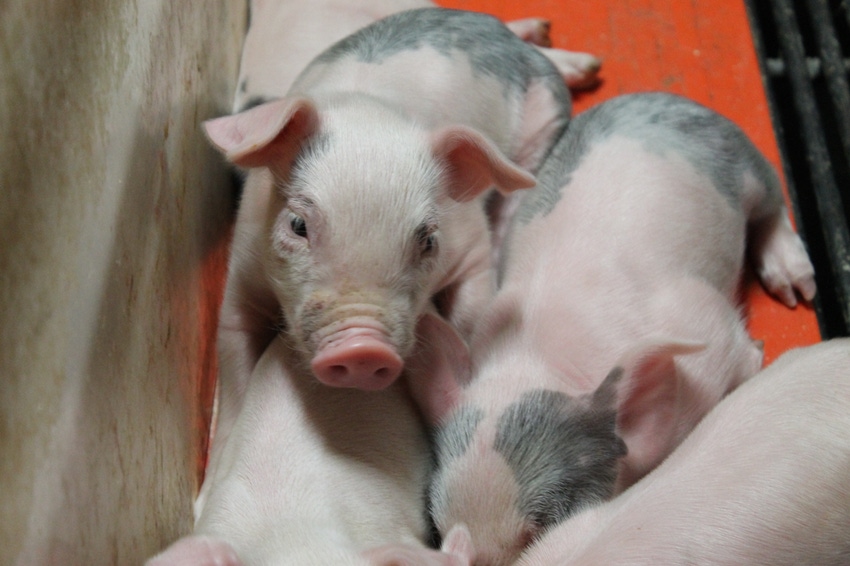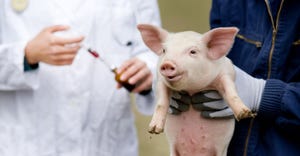Impact of farrowing management practices on influenza infections
Enhanced biosecurity practices not enough to significantly decrease infection levels at weaning.
March 9, 2021

Influenza is a respiratory disease that affects pigs and causes economic losses due to its impact on growth, feed conversion and susceptibility to secondary infections. Piglets are a key subpopulation capable of maintaining infections endemic in breeding herds and of spreading the virus to distant locations at weaning. Piglets are born naïve to influenza A virus, but many become infected during the pre-weaning period. Controlling influenza in piglets should be a priority in the overall control of influenza infections.
There are no standard protocols for controlling or eliminating influenza from breeding herds. Traditionally, vaccination of pregnant sows has been widely implemented in the U.S. with the aim of boosting the transfer of maternally derived antibodies to their offspring so that piglets withstand influenza infections until they are capable of mounting an effective immune response. The ability of influenza virus to mutate and reassort has limited the long-term efficacy of vaccines and has facilitated the persistence and dissemination of influenza in breeding herds.
There are management practices that can facilitate the spread of influenza infections in breeding herds. Studies from our group at the University of Minnesota have shown experimentally how farm workers can be mechanical carriers of influenza to naïve pigs after having had close contact with infected piglets (Allerson et al., 2013). We have also showed how nurse sows can transmit influenza to adopted piglets (Garrido-Mantilla et al., 2020) and have quantified the impact of influenza sow vaccination on prevalence at weaning (Chamba et al., 2020).
To further advance the control of influenza in breeding herds, we set out to evaluate the impact of internal biosecurity practices on influenza infections during the pre-weaning period. These practices included limiting pig movement (i.e cross-fostering), changing disposable gloves when handling pigs and changing boots when entering the farrowing crates. Additionally, we wanted to explore the level of contamination of influenza on the hands of farm workers handling piglets to better understand sources of influenza spread to young pigs.
To address the goals of our study, we investigated influenza infections in three breeding herds known to be influenza positive. In each farm we selected 120 litters, assigned to either a treatment or control group. The treatment group consisted of enhanced biosecurity practices such as no cross-fostering after one day of age, changing gloves between litters and no use of nurse sows in the group. Litters in the control group were handled and managed following standard on-farm management practices.
In order to assess the impact of the interventions in influenza infections, litters were sampled by using udder skin wipes from lactating sows and environmental wipes from farrowing rooms at multiple time points during the pre-weaning period to evaluate shedding. Sow shedding was also investigated by collecting nasal swabs from sows at farrowing and weaning. We also collected wipes from workers’ hands and tools used for piglet handling.
The results of this study revealed a delay on influenza infections in litters where the enhanced biosecurity practices were implemented, but these practices were not enough to significantly decrease infection levels at weaning. Overall litters that did not follow biosecurity practices had four times higher odds of becoming infected that litters handled following stricter biosecurity practices. It is important to mention that the farms in this study had high levels of influenza infections at weaning and did not use influenza vaccination. Further investigations should include the implementation of practices in vaccinated herds in a sequential way.
Important findings of this study also included the detection of influenza at ages as young as two days old and the limited detection of influenza in sows at farrowing. Only two sows out of 360 tested positive. These results indicate that sows are not playing a significant role at introducing influenza infections to piglets during lactation. On the contrary, sows appear to become infected from the piglets since 30% of the sows tested influenza positive at weaning.
Lastly, 56% of the samples collected from farm workers’ hands and the tools used for piglet handling tested influenza positive, suggesting that fomites and hands of farm workers may be a main driver of influenza spread among litters.
In summary, our results showed that management practices that promote pig movement and handling of pigs without changing disposable gloves between litters facilitate the maintenance and dissemination of influenza within farrowing rooms. Further strategies that combine management practices and vaccination against influenza should be explored for a comprehensive control of influenza infections.
Sources: Gustavo Lopez Moreno, Montserrat Torremorell, University of Minnesota College of Veterinary Medicine, who are solely responsible for the information provided, and wholly own the information. Informa Business Media and all its subsidiaries are not responsible for any of the content contained in this information asset.
References
Allerson, M. W., Cardona, C. J., and Torremorell, M., 2013, Indirect Transmission of Influenza A Virus between Pig Populations under Two Different Biosecurity Settings, PLoS One, vol. 8, no. 6, pp. 2–10.
Garrido-Mantilla, J., Culhane, M. R., and Torremorell, M., 2020, Transmission of influenza A virus and porcine reproductive and respiratory syndrome virus using a novel nurse sow model: A proof of concept, Vet. Res., vol. 51, no. 1, pp. 1–10.
Chamba, F.O., Matthe, P., Marie, W. A., Morrison, R.B., Davies, P. R., and Perez, A., 2020, Effect of influenza A virus sow vaccination on infection in pigs at weaning : A prospective longitudinal study, no. June, pp. 1–11.
You May Also Like



